Click on a picture to enlarge it
| Snakes in Movies Group Pages |
All Movie Snakes Must Die! |
| All Movie Snakes Want to Kill You! |
| Dancing With Snakes |
| Giant Monster Snakes |
| Pet Snakes |
| Shooting Snakes |
| Snake Bites |
| Snake Charmers |
| Snake Face |
| Snake Fights |
| Snake People |
| Snake Pits |
| SnakeSexploitation |
| Snakes & Skulls |
| Snakes Run Amok |
| Snakes Used as Weapons |
| Snakes Used for Comedy |
| Snakes Used for Food or Medicine |
| Snakes Used Realistically |
| Throwing and Whipping Snakes |
| Kinds of Snakes |
| Rattlesnakes |
| Cobras |
| Black Mambas |
| Boas, Pythons, and Anacondas |
| Unusual Species
|
| Settings |
| Snake in the House! |
| Snakes in Beds |
| Snakes in
Jungles and Swamps |
| Snakes In Trees |
| Genres & Locations |
| Snakes In Westerns |
| Snakes in Asian Movies |
| Herps in Australian Movies |
| Herps in James Bond Movies |
| Herps in Silent Movies |
| Herps in Spielberg Movies |
| Snakes in Movies | ||
| Wind Across the Everglades (1958) | ||
| Spoiler Alert ! Some of these pictures and descriptions may give away plot details that you might not want to know before watching the film. |
||
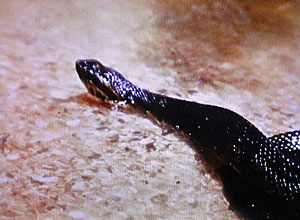 |
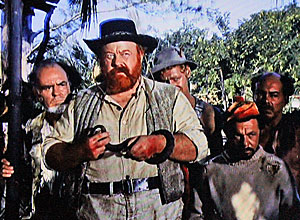 |
 |
 |
 |
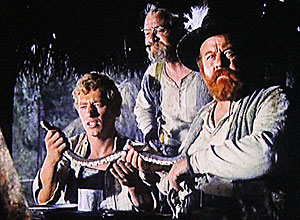 |
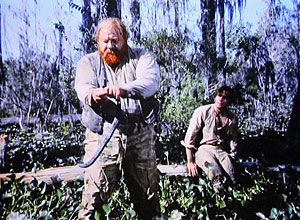 |
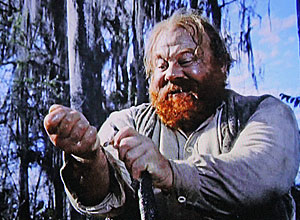 |
 |
| When I saw that this was directed by the great Nicholas Ray (who directed Rebel Without a Cause, In a Lonely Place, and Johnny Guitar) from a screenplay written by Budd Schulberg (who wrote the Academy Award-winning screenplay for On the Waterfront) I had to find and watch this. It makes some very interesting comments on personal freedoms and exploiting nature for profit vs. protection the natural world, but even though it professes to be about respecting and protecting and understanding the natural world, it offers the same old myths and idiotic uses of snakes that foul up so many movies. It's set at the beginning of the 20th century in Miami, which is described as a sleepy frontier town. Walt Murdock comes to Miami to teach natural science but he is immediately thrown in jail for ripping feathers out of a woman's hat and chastising her for killing birds. Large feathers from the plumes of waterbirds such as Egrets, Herons, and Spoonbills, were very popular on women's hats of that era, and the large-scale killing of the birds threatened them with extinction. This part is all true. The Audubon Society hired rangers to protect the birds and after several of them were killed, legislation was passed to protect the birds. Murdock is freed from jail on the condition that he work as an Audubon ranger which he gladly accepts. His nemesis is a poacher named Cottonmouth, a real larger-than-life anti-hero played by Burl Ives. Cottonmouth lives deep in the Everglades with his band of outlaws and thinks that he and his men have the right to do whatever they want to survive. They live a lusty life free of worries and responsibility and sum up their philosophy in one word "protest." Against civilization and its laws and restrictions, including the prisons that some of them have escaped from. Cottonmouth's describes life as "Eat or be et." and repeatedly proclaims "Ah! The sweet tastin' joys of this world!" One of the more articulate outlaws tells us Cottonmouth "carries the freedom of the individual to its logical conclusion." But that conclusion involves selling the feathers of huge numbers of nesting birds that are slaughtered with shotguns in areas where they are protected by the State and Federal Government and the National Audubon Society, so Murdock is determined to capture Cottonmouth to save the birds. Enough of the real movie, on to the snakes. You can't have a movie set in a swamp or in the Everglades without showing snakes and alligators and this one is no exception. As people are traveling through the glades, we see snakes here and there just part of nature, along with birds, bears, alligators and other wildlife. But Cottonmouth also carries around what somebody in town describes as a "cottonmouth snake" in his pocket implying that he uses it as a weapon. He seems to be holding it constantly, draped around his neck. He opens his vest to talk to it once, and we find out that he has named it Curly Cue. (Of course, it's not really a venomous Cottonmouth, but a species of Nerodia or Water Snake. And it's a live snake, too, which appears to be slowed down by drugs or by cold because it barely moves.) When Cottonmouth gives the snake to his son he tells him to "find him a nice fat frog for supper." As you might suspect, Cottonmouth meets his end when he reaches for his hat in the water and a different snake bites him on the wrist, holding on so tight that Cottonmouth has to rip its fangs out as he screams "bite thee brother, bite thee!" He dies in about two minutes. So much for telling the truth about the natural world - it's very unlikely the snake would hold tight after striking and even more unlikely anybody would die so quickly from Cottonmouth venom. But that's Hollywood. At least they got a lot of other things right in this one. |
||
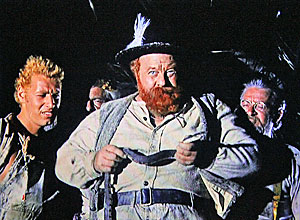 |
 |
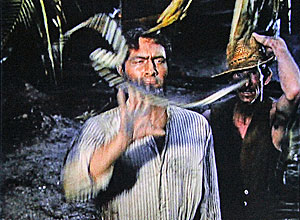 |
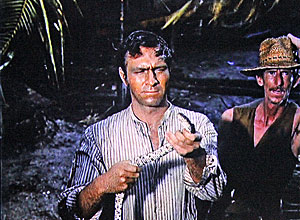 |
 |
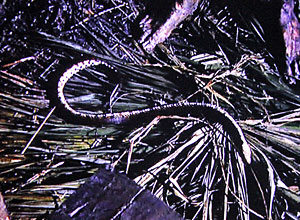 |
| When Murdock comes to Cottonmouth's hideout, Cottonmouth throws his snake at Murdock so he will die of "natural causes." But Murdock is a man of the outdoors and knows how to deal with snakes thrown at him by madmen. He simply grabs it by the back of the head, then viciously snaps it dead and throws it on the ground. I guess for him birds deserve to live, but he couldn't be bothered to just throw the live snake into the brush. Cottonmouth says "Curly Cue was the best friend I had around here." but doesn't make a big fuss about its death. In fact, it seems to make him respect Murdock more. | ||